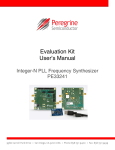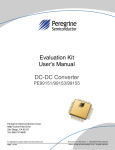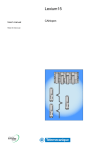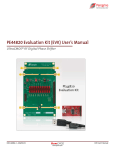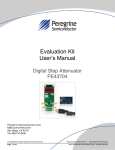Download PE97022 EVALUATION KIT USER`S MANUAL
Transcript
PE97022 EVALUATION KIT USER’S MANUAL Peregrine Semiconductor Corp. 9380 Carroll Park Drive, San Diego, CA 92121 (858) 731-9400, Fax (858) 731-9499 http://www.psemi.com 79-0119-01 www.psemi.com ©2008 Peregrine Semiconductor Corp. All rights reserved. Page 1 of 16 Table of Contents Introduction ................................................................................................................... 3 Introduction .................................................................................................................. 4 Applications Support .................................................................................................... 4 FCC Labeling Requirement .......................................................................................... 4 Hardware Section .......................................................................................................... 5 Evaluation Kit Contents & Requirements ..................................................................... 6 Evaluation Kit Configuration ......................................................................................... 7 Evaluation Kit Setup ..................................................................................................... 8 Software Section ......................................................................................................... 12 Software Installation Instructions................................................................................ 13 Printer Port Programming........................................................................................... 13 Software Operation Instructions ................................................................................. 13 Programming Tip........................................................................................................ 14 ©2008 Peregrine Semiconductor Corp. All rights reserved. Page 1 of 16 79-0119-01 www.psemi.com © Copyright 2001 Peregrine Semiconductor Corp. All rights reserved. Printed in the United States of America. No part of this publication may be reproduced, photocopied, stored in a retrieval system, or transmitted by electronic, mechanical or any other means without prior written permission of Peregrine Semiconductor Corp. Peregrine Semiconductor Corp., the Peregrine logotype, and UTSi are registered trademarks of Peregrine Semiconductor Corp. PE97022 is a trademark of Peregrine Semiconductor Corp. Peregrine Semiconductor Corp. reserves the right to make improvements to the hardware, firmware or software described in this manual at any time and without notice. While the accompanying material has been carefully reviewed to insure the most accurate information possible, the data are not warranted for absolute accuracy or completeness and are subject to change without notification. Peregrine Semiconductor Corp. Life Support Policy Peregrine Semiconductor Corp. products are not intended for use in life-critical situations, or as critical components in life-support devices or systems. Life-support devices or systems are defined as devices or systems that are intended for surgical implant into the body, or that support or sustain life, and whose failure to perform when used in accordance with the instructions provided by the manufacturer, might result in injury to the user. FCC Compliance Statement This device is intended for use only in a research and development environment. It has not been tested for compliance with FCC regulations regarding interference with radio frequency energy. It might cause harmful interference with radio communications. The user assumes responsibility for any interference caused by this device. ©2008 Peregrine Semiconductor Corp. All rights reserved. Page 2 of 16 79-0119-01 www.psemi.com Introduction ©2008 Peregrine Semiconductor Corp. All rights reserved. Page 3 of 16 79-0119-01 www.psemi.com Introduction This Evaluation Kit is specifically designed for evaluating the PE97022 3.5 GHz IntegerN PLL. The Evaluation Kit allows maximum flexibility for optimizing phase noise, spur, lock time and power performance for specific applications. Using the hardware and software provided in the Evaluation Kit both serial and direct modes of programming can be demonstrated. Applications Support If you have a problem with your evaluation kit, software, or if you have applications questions call (858) 455-0660 and ask for applications support. You may also contact us by fax or e-mail: Fax: (858) 455-0770 E-Mail: [email protected] FCC Labeling Requirement This device complies with Part 15 of the FCC Rules. Operation is subject to the following two conditions: (1) this device may cause harmful interference, and (2) this device must accept any interference received including interference that may cause undesired operation. ©2008 Peregrine Semiconductor Corp. All rights reserved. Page 4 of 16 79-0119-01 www.psemi.com Hardware Section ©2008 Peregrine Semiconductor Corp. All rights reserved. Page 5 of 16 79-0119-01 www.psemi.com Evaluation Kit Contents & Requirements The Evaluation Kit includes all of the specific software and hardware required to evaluate the PE97022. Included in the Evaluation Kit are: 1 PE97022 Evaluation Board 1 PE97022 3.5 GHz Integer-N PLL 1 Peregrine CD-ROM with application software included 2 Jumpers 1 4-Wire Interface Cable with GND 3 Power Supply Cables 1 Set of Evaluation Kit Data Plots In order to program the part using serial programming mode the Evaluation Kit software will need to be installed on a computer with the following minimum requirements: PC Compatible with Windows™ ’95/98/2000/XP Mouse Parallel Port HTML Browser to access CD contents CAUTION: The PE97022-EK circuit contains components that might be damaged by exposure to voltages in excess of the specified voltage, including voltages produced by electrostatic discharges. Handle the board in accordance with procedures for handling static-sensitive components. Avoid applying excessive voltages to the power supply terminals or signal inputs or outputs. ©2008 Peregrine Semiconductor Corp. All rights reserved. Page 6 of 16 79-0119-01 www.psemi.com Evaluation Kit Configuration The PE97022 Evaluation Board is configured with an on-board VCO, TCXO reference and a second order active loop filter. The loop filter is followed by a low pass filter after the Op Amp. The VCO tuning range is 3000 MHz to 3500 MHz and the reference oscillator runs at 20 MHz. The active loop filter is designed for a 20 MHz comparison frequency and a 3000 MHz output frequency with unity gain crossover at 50 kHz. The data provided was measured in this configuration with the default jumper settings shown in Figure 2. Two jumpers (JP1 & J3) configure the Evaluation Board to operate with either the onboard reference oscillator (TCXO) or an external reference applied to J10. Figure 2 shows the proper configuration for utilizing the TCXO reference. JP1 in the middle-toright connection as shown connects the output of the TCXO to the PLL FR input, while J3 installed provides power to the TCXO. Do not connect any external reference to J10 if the on-board reference is selected. Figure 3 displays the proper configuration for utilizing an external reference source. JP1 is in the middle-to-left connection, which connects the PLL FR input to the J10 SMA connector and the jumper on J3 is removed to power-down the TCXO. The PE97022 Evaluation Kit also allows for manual programming using the fifteen onboard switches. Setting the BMODE Control switch ON (BMODE switch S3-1) enables direct mode programming. Setting the BMODE Control switch to the OFF position (S3-1) and the A3-S_mode switch to the ON position (S3-8) the serial programming mode is enabled allowing for software control. The default jumper and switch settings are shown in Figure 2, which will place the part into serial programming mode utilizing the on-board reference. Peregrine Semiconductor recommends that the default settings be used initially to bring up the evaluation board and duplicate the enclosed measured data. ©2008 Peregrine Semiconductor Corp. All rights reserved. Page 7 of 16 79-0119-01 www.psemi.com Evaluation Kit Setup 1. Verify a jumper is placed on the connector J3 and REF Selector (JP1) is positioned to select the on-board reference as shown in Figure 2. 2. Connect power supply cables to the Evaluation Kit board as shown in Figure 1. Verify all supplies are turned off prior to connecting to evaluation board. Î Connect the +3.3 V supply to VccPLL (J7 Pins 1 & 3) Î Connect the +5 V supply to VccVCO (J7 Pins 31 & 33) Î Connect the ±6 V supply to VccOpAmp J7-13: +6 V Red Connector J7-15 & J7-17: GND Green Connector J7-19: -6 V Black Connector 3. Using the application software provided and described in detail in the next section, serial and direct programming can be evaluated. To enable software control of the evaluation board, ensure all DIP switches are turned OFF except for ENH (S1-1) and A3-S_Mode (S3-8) as shown in Figure 2. The 4-wire interface cable (3-wire serial interface and GND) should be connected from your computer’s printer port to J1 on the evaluation board to enable software control. 4. Direct mode programming can be evaluated manually without the Application Software enabled. To enable direct mode programming, both the ENH (S1-1) and the Bmode (S3-1) DIP switches should be turned on. The on-board DIPswitches can then be used to manually program the PLL. Note that M7 register is not available in the direct mode programming. Instructions for programming PLL registers are available in the datasheet. 5. The output of the on-board VCO can be measured by connecting a spectrum analyzer to port J5. Additional GND posts and test points are available on the Evaluation Board for measurement flexibility. 6. Refer to the next section for further information on configuring and running the application software. ©2008 Peregrine Semiconductor Corp. All rights reserved. Page 8 of 16 79-0119-01 www.psemi.com Figure 1. Typical Setup for Evaluation Kit Measurements J10: External Reference Input (Do not connect if on-board TCXO is used) TCXO J1: 8-Wire Serial Interface to Computer Printer Port (Supplied in Kit) (J7 Harness Supplied in Kit) S1 PLL VDD J7: 1,3 S2 Op Amp VPOS J7: 13,15,17,19 +3.3 V Supply +/-6 V Supply Int-N PLL S3 VCO VCO VDD J7: 31,33 +5 V Supply J5: VCO Output to Spectrum Analyzer ©2008 Peregrine Semiconductor Corp. All rights reserved. Page 9 of 16 79-0119-01 www.psemi.com Figure 2. Evaluation Kit Default Jumper & Switch Settings. External Reference Input S1 Switch 1 ON Enhanced Mode OFF JP1 set to utilize on-board reference J3 on-board reference supply PLL +3.3 V Supply J7: 1,3 Op Amp +/-6 V Supply J7: 13,15,17,19 VCO +5 V Supply J7: 31, 33 S2 Switch 8 ON Serial Programming Enabled ©2008 Peregrine Semiconductor Corp. All rights reserved. Page 10 of 16 VCO Output 79-0119-01 www.psemi.com Figure 3. Jumper Setting to Disable On-board Reference. External Reference Input JP1 set to utilize external reference (left two pins shorted) J3 jumper removed ©2008 Peregrine Semiconductor Corp. All rights reserved. Page 11 of 16 79-0119-01 www.psemi.com Software Section ©2008 Peregrine Semiconductor Corp. All rights reserved. Page 12 of 16 79-0119-01 www.psemi.com Software Installation Instructions In order to setup the Evaluation Software on your computer: 1. Start Microsoft Windows™ ’95/98/2000/XP. 2. Insert the Peregrine CD into CDROM drive. If your computer has AutoPlay enabled and the splash screen automatically appears, select the Products link at the bottom of the splash screen. If the Peregrine splash screen does not automatically appear, utilize Windows Explorer to browse the CD directory and open the file \cd\startup.htm. 3. Select the PE97022 link on the Products page to obtain product information and evaluation kit documentation. 4. Select the Evaluation Board Software link and choose the option of “Run this program from its current location.” Identify the desired directory for installation and select the Unzip option when the WinZip Self-Extractor window appears. 5. Utilize Explorer to run Setup.exe from your hard disk directory and follow the instructions on the screen. This will install the Evaluation Kit Application Software in the selected directory and add a shortcut to the Windows Start menu. Printer Port Programming When programming the PE97022 in serial mode using the computer printer port option, the following software programming features are not available: Î Enhancement modes Î Parallel and Direct interface modes Î Ping-pong mode Ping-pong mode may be implemented on the evaluation setup by attaching a squarewave generator to J1-5 pin of the Serial Control connector and programming both primary and secondary registers. Software Operation Instructions To run the PE97022 using your computer’s parallel port follow steps 1 through 7 below and reference Figure 4. Step 1: Start the Peregrine Integer-N PLL EK Control program. This is a generic program for all Interger-N PLL’s at Peregrine Semiconductor. ©2008 Peregrine Semiconductor Corp. All rights reserved. Page 13 of 16 79-0119-01 www.psemi.com Step 2: Select the PE97022 from the pull-down menu button in the upper left corner of the program screen. This selection will enable certain product specific modes of operation. Step 3: If the on-board reference is being used, set the reference frequency to 20 MHz by typing 20 into the reference frequency box. If an external reference is applied, type in the appropriate reference value in MHz. Step 4: Set reference counter (R counter) to 0 by entering it into the R counter box in the "R M A Select" box in the bottom left corner. Note that the numbers in the orange boxes are computed values and cannot be directly typed in. Step 5: Verify frequency step = 20.00 MHz. Step 6: Set Frequency to 3000 MHz by typing it into the secondary register frequency box. Once the frequency values are entered by "Enter" key in the keyboard, the software will automatically send out data to program PLL. You can also click the "Send Data" button to program PLL. Step 7: Verify on the spectrum analyzer that the part locks at 3000 MHz. Programming Tip When the PLL is first powered on and before programming, the Op Amp output could be resting at a negative voltage preventing proper VCO operation. The PLL will not lock in this condition. If this mode occurs, the power supply for Op Amp (± 6V) should be cycled. To prevent this from happening, the following power on sequence is recommended: 1. Turn on power supplies for PLL VDD and VCO VCC. 2. Program PLL. 3. Turn on the power supply for the Op Amp. ©2008 Peregrine Semiconductor Corp. All rights reserved. Page 14 of 16 79-0119-01 www.psemi.com Pulldown product menu Register selection Prescaler bypass option Figure 4. PE97022 Software Control Panel Î Light blue number boxes identify user defined program states and can be modified by utilizing the arrows next to the boxes or clicking into the box and typing the appropriate value. Either clicking on the light blue switches or typing the counter variable into the text box can program the registers. Î The primary or secondary register can be selected utilizing the switch identified in the upper right side of the panel. Î The prescaler can be either enabled or bypassed depending on switch position. Î Data is sent to the evaluation board with every change in register value. To force data across the bus, click on the dark blue “Send Data” button below the loop diagram. ©2008 Peregrine Semiconductor Corp. All rights reserved. Page 15 of 16 79-0119-01 www.psemi.com




















